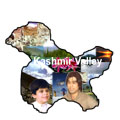 |
Leh District Ladakh
has been dubbed, somewhat romantically, the last Shangri la,
the Moonland, and even Little Tibet; yet all these descriptions
hold some truth. Ladakh is the most remote region of Kashmir.
It is a barren, virtually rainless, high altitude area which
lies north of the Himayayas on what is known, geographically,
as the Tibetan Plateau. The Himalayas serve as a barrier to
the clouds carrying rain from south so virtually none of it
gets across to fall on Ladakh. As a consequence the region has
only a few cm of rain per year (as little as the Sahara), creating
the 'moonland' effect - a barren, grey-brown, yellow-white landscape
utterly devoid of vegetation. Only where rivers carry water,
from far-off glaciers or melting snow, to habitation do you
find plant life. Ladakh really does seem to be a miniature version
of Tibet. Apart from the fact that Ladakh is on the Tibetan
Plateau and the two regions have experienced a similar isolation
from the rest of the world, the people of Ladakh and Tibet are
also related and share a cultural and religious heritage that
goes back centuries. Ladakh also has many refugees who fled
Tibet with the invasion from China. In fact, Ladakh today is
probably far more Tibetan than Tibet, which has been considerably
changed by the Chinese. Finally, Ladakh could well be the last
Shangri la. Due to its strategic location the area is disputed
by the Indians, Pakistan and Chinese - it was virtually closed
to outsiders from the end of WW II until 1974. The daunting
height of the Himalayas added to this isolation. Even now the
main route into Ladakh is open for less than six months of each
year. Also until 1979 there was no regular civilian flight into
Ladakh, so from October to June the region was completely cut
off.
|
